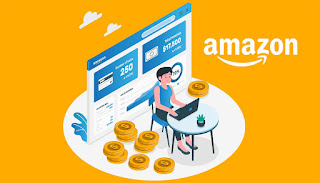How much will it cost to sell on Amazon?
The selling process on Amazon is an excellent opportunity to enter the world of e-commerce, mostly because of the benefits and simplicity it can be.
Amazon has reported a profit in the range of $108.5 billion during the quarter that began in 2022's first quarter. This is a sign of the extent to which Amazon has been expanding.
Having said that, starting your selling career on Amazon is a wise choice if you are well aware of the expenses involved.
Amazon seller fees cover the costs of using Amazon as a platform to sell your goods as well as those associated with using fulfillment centers, inventory, and other expenses.
The fees that you will need to budget for are listed below so you can see just how much it costs to sell on Amazon.
Listing and selling fees on Amazon
Seller Type
Either an Amazon Individual seller or an Amazon Professional seller can register on Amazon Seller Central. This depends on how many things you intend to sell and how big your firm is. Fulfillment fees
For those who intend to sell fewer than 40 goods per month, the Individual Selling Plan is designed. There is no recurring monthly cost, but you must pay $0.99 to Amazon for each item you sell. You also have limited access to Amazon seller resources thanks to this.
For larger enterprises that sell more than 40 items each month, the professional selling plan is designed. Here, sellers only have to pay a $39.99 monthly subscription price rather than extra fees for each item they sell. Additionally, you have total, unrestricted access to all of Amazon's seller services.
For a step-by-step lesson on how to set up your Amazon Seller Central account, check out the SellerApp tutorial.
Amazon sellers have two options for fulfilling the following:
Fulfillment by Amazon
With this approach, Amazon will take care of all fulfillment choices for your products. This covers all of your things' storage in Amazon's warehouses, shipping, packing, product returns, and customer service.
Depending on your order, you may be required to pay a fee, and the cost will directly relate to the size of your order. This implies that products with more weight and size will have higher costs.
The cost of storage for a year beginning in January ranges from $0.69 to $2.40, and there will be additional expenses when the year is up.
Fulfillment by Merchant
A professional seller has the ability to select the shipping costs he wants. Afterward, he will be compensated for delivery in accordance with the customer's chosen shipment method and the category of his products.
There may be a minor issue here since the seller must use the proper shipping methods, which may result in greater shipping expenses than the real rate of the shipment credit that he receives.
Costs for customer returns
The best-selling feature of Amazon is its excellent customer service, which you as a vendor must follow. Customers have the choice to exchange and return goods whenever it is most convenient for them.
This implies that sellers must pay expenses for every item that is returned to the warehouse. You can use tools like the Amazon FBA calculator from SellerApp to easily keep track of all these factors.
Referral fees
In exchange for using Amazon as a platform that makes their products available to customers worldwide, sellers must pay Amazon a referral fee that is levied on each item sold.
The referral fees range in price from 6% to 20%. Typically, the basic rate is 15%, or $0.30. It is computed as a percentage of the final sale price and varies depending on the type of goods being sold.
Costs of photography and advertising
Advertising is essential for a seller to succeed, and advertising expenses must be carefully budgeted. The cost per click is typical $0.81, though it can change based on the campaigns you run.
In order to reach as many people as possible, it's critical to research your target audience and make wise financial decisions. Utilizing tools to handle your advertising will save you from manually doing it.
Product photography is crucial for your advertising and product listings. To stand out from the competition as a vendor, you must employ high-quality, professional images, which will cost money but increase your sales.
Cutting back on fees
Although it's not as simple as charges may appear, there are a few tricks and techniques to lower the cost of the selling process. Here are a few of them.
A professional Seller Account is more affordable as it gives you unlimited features and services for all your listings, and can result in savings.
Items that weigh less and have more profit margins will be more lucrative to sell since warehouse costs incurred for storage are calculated on the size and weight of the item.
Bundling is an excellent method to reduce costs because it means you're paying fulfillment costs for the whole bundle instead of having to pay for each item included in it.
Be aware of the exact amount of fees you have to pay as you might be charged more for referral or storage costs due to mistakes in listing.
Make use of the appropriate tools to estimate your costs and ensure that you're making the most profit from your sales by using the right tools for data analysis.
Conclusion
You need to cut costs anywhere you can if you want to be a successful vendor. Due to the services that a seller may use, the fees set by Amazon are non-negotiable; however, it is beneficial to keep in mind all of the information mentioned above and reduce fee spending.



Comments
Post a Comment